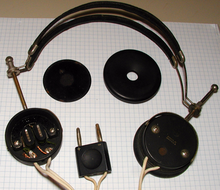Electromagnetic speaker
Electromagnetic speakers were often used in the early days of audio technology, but are no longer in use.
In the case of electromagnetic loudspeakers, either an iron membrane is moved, which radiates the sound directly (see sketch), or an iron rod enclosed by a coil oscillates in front of the air gap of a permanent magnet and is connected to a paper membrane. Such loudspeakers are no longer built today. A superimposed constant field and the LF alternating field drive a ferromagnetic membrane.
The disadvantages of these constructions are:
- high harmonic distortion, as the force on the one hand depends on the distance and on the other hand is not linear but dependent on the square of the current,
- Unsuitable, heavy, resonant material necessary for membrane or iron rod, which leads to a tinny sound.
- A force must also be applied in the resting state, so the vibrating iron part (membrane or iron rod) must be heavy and stiff, which leads to poor bass (high resonance frequency due to high stiffness) and high-frequency reproduction (high mass).
This principle is also used in magnetic microphones and electromagnetic headphones (both obsolete), as well as in telephone mouthpieces. The reverse principle is still used with electromagnetic (moving iron) record scanners (MI).
literature
- Helmut Röder, Heinz Ruckriegel, Heinz Häberle: Electronics 3rd part, communications electronics. 5th edition, Verlag Europa-Lehrmittel, Wuppertal, 1980, ISBN 3-8085-3225-4

